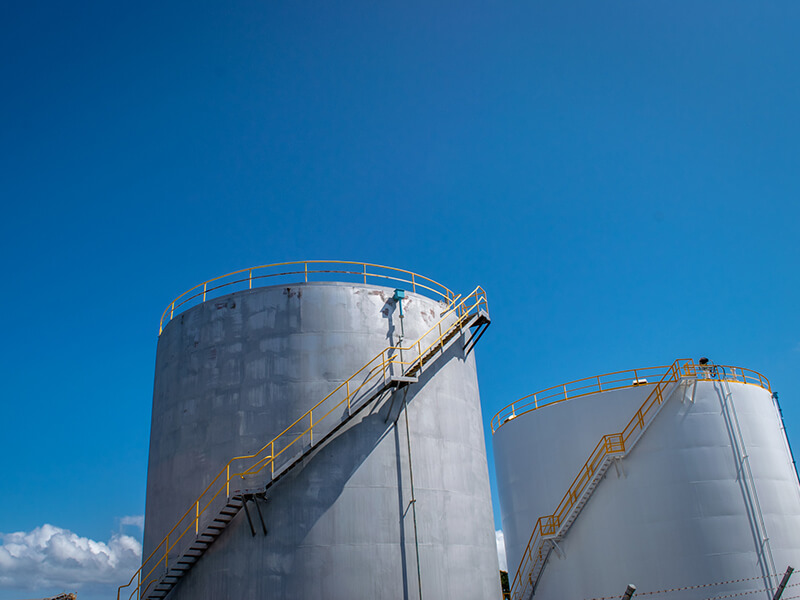The Jawaharlal Nehru Port Trust (JNPT) at Navi Mumbai is the premier container handling port in India, accounting for around 50% of the total containerized cargo volume, across the major ports of India. Commissioned on 26 th May 1989, in three decades of its operations, JNPT has transformed from a bulk- cargo terminal to become the premier container port in the country. JNPT is connected to over 200 ports in the world and is ranked 33rd in the list of top 100 Container Ports globally.
| ✔ | This is an ISO 9001: 2015 certified terminal |
| ✔ | Warehousing facilities for storage of imported and exported liquid products, petroleum & petrochemicals of Class ‘A’, ‘B’ & ‘C’ such as SKO, HSD, Naphtha, Furnace Oil, Caustic Soda, Ethanol, Methanol, Sulphuric Acid, Edible oil, Ethylene Dichloride |
| ✔ | Total capacity : approximately 283000 KL with tanks which include MS, SS tanks. Individual Tank capacity varies between 500 KL to 14000 KL |
| ✔ | Twenty-six number of bays for tank lorry filling with loading capacity of 400 road tankers per day |
| ✔ | Rail wagon loading facility with SS & MS Steel tank containers |
| ✔ | Four number of cargo lines from jetty to terminal out of which 1 x 18" dia is of MS, 1 x 12" dia is of MS, 1 x 8" dia SS and 1 x12" dia SS material |
| ✔ | Jetty main liquid length & width continuous piled 275 M long & 40.5 M wide with facility to berth ships on both sides |
| ✔ | Main liquid jetty having capacity to accommodate two vessels at a time:1,00,000 DWT in seaside berth & 50,000 DWT on shore side berth |
| ✔ | Jetty is provided with six 12' marine loading and unloading arms (three on seaside and three on shore side), firefighting system as per OISD 156 norms and state-of-art environmental protection measures |
| ✔ | In addition, there is a shallow jetty 200 metres long and facility to berth three vessels at a time |
| ✔ | Pigging facility-all four lines are piggable |
| ✔ | Total annual throughput in terms of volume approximately 1.5 million cm. |

| Berth Details | Max. LOA(m) | Max. Draft(m) | Max. Displacement (MT) |
|---|---|---|---|
| Outer berth-LB1 | 330 M | 16.2 M | 1,20,000 MT |
| Inner berth-LB2 | 185 M | 12.2 M | 45,000 MT |
| Shallow Jetty SB1 | 75 M | 8 M | 3000 MT (BARGING OPERATIONS) |
| Shallow Jetty SB 2 | 183 M | 10 M | 30,000 MT |
| Shallow Jetty SB 3 | 183 M | 10 M | 30,000 MT |

| ✔ | Independent safety officer directly reporting to the CEO |
| ✔ | Periodic Mock drills and monthly safety meeting are conducted to assess the preparedness of staff towards emergency control |
| ✔ | Periodic safety trainings are provided to the staff. |
| ✔ | Disaster control management plan is in place with On-Site and Off-Site Emergency Plan. |
| ✔ | Standard Operating Procedures are in place and followed for every operation. |
| ✔ | Work Permit System covering hot work, cold work, excavation, vehicle entry, electrical isolation and work at height is in place |
| ✔ | Basic safety rules like proper usage PPE, naked light regulations etc. are strictly followed |
| ✔ | Fixed fire-fighting system comprising of fire water storage, pumps, pipeline network, hydrant valves, monitors and water sprinkler system |
| ✔ | Preventive maintenance, testing and calibration of equipment are practiced |
| ✔ | Portable fire extinguishers located strategically at the operating and administrative area. |
| ✔ | The terminal is round-the-clock manned to avoid any possible threat. |
| ✔ | Streamlining the movement of road tankers inside premises is done by security personnel to avoid interference between incoming & outgoing tankers |
| ✔ | All equipment/machinery are of standard make and noise level within the standard limits |
| ✔ | State of the art Effluent Treatment Plant (ETP) with Zero Liquid Discharge |
| ✔ | No hazardous emissions to the atmosphere. DG exhaust quality is monitored frequently and maintained within the permissible limits |
| ✔ | Loading/unloading of road tankers is through the pipelines in a closed-circuit manner to avoid any leakage. |